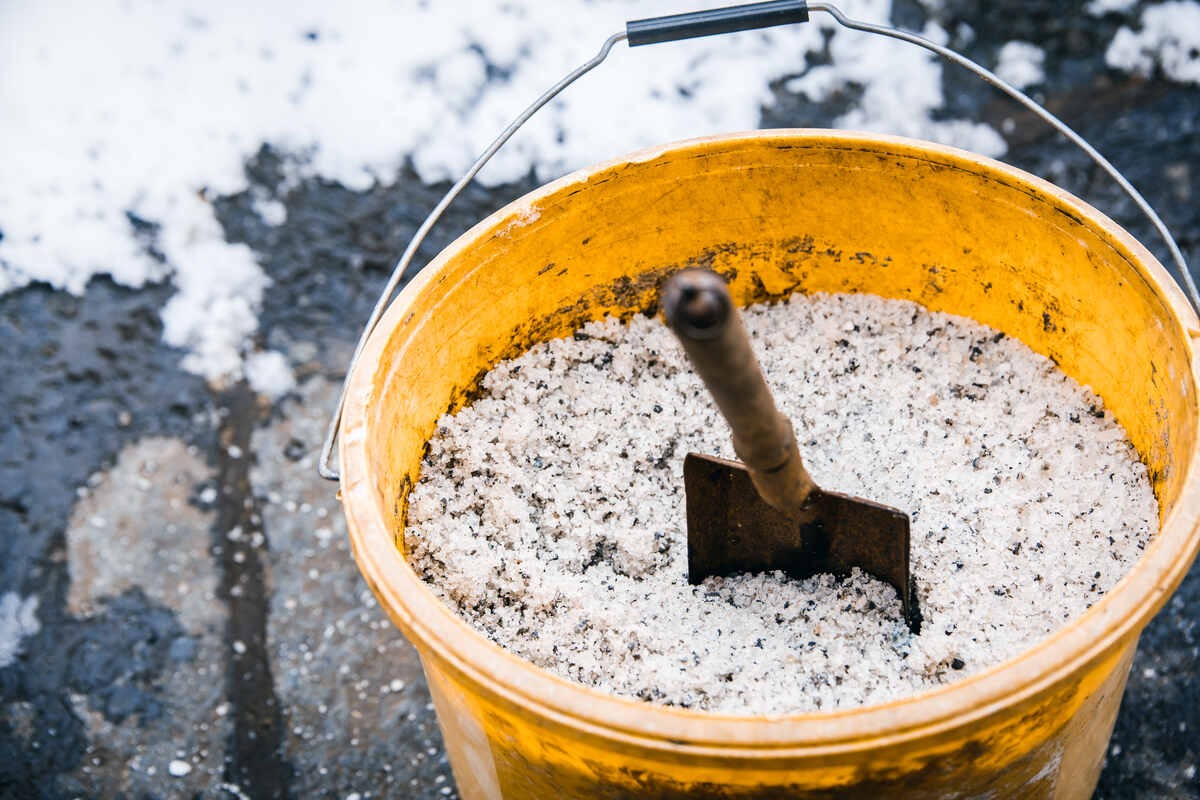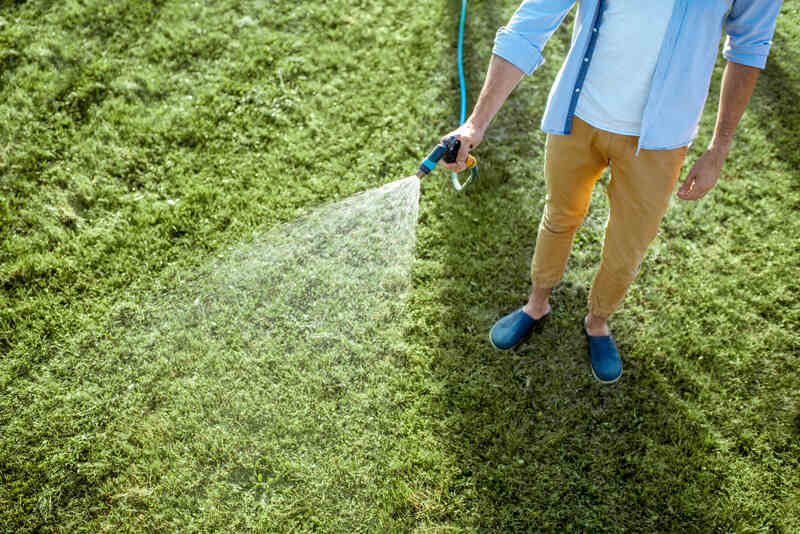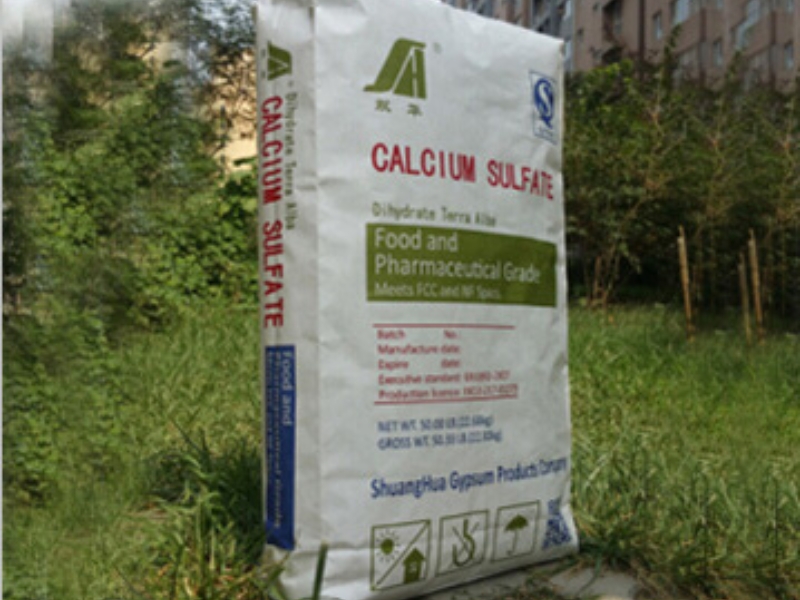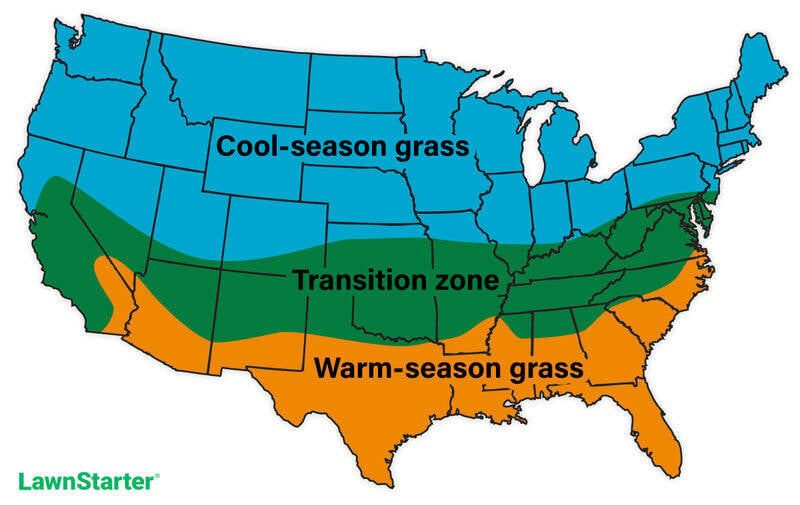
Ice melt is an invaluable resource during winter when the weather creates treacherous conditions on your walkways and driveway, but it can also damage your grass. To repair salt damage on your lawn, you’ll want to move any residual salt out of the root zone with gypsum and water and fix any bare spots that occurred by topdressing and overseeding.
In this article, we’ll walk you through the steps, from leaching salts out with water, to overseeding.
What Salt Does to Your Lawn
Salt from de-icing products can wreak havoc on your lawn, mainly when the sodium or chloride — depending on what product you are using — builds up in the soil.
- Dehydrates the grass: Salt in the soil draws moisture from the grass blades and roots through a process called osmosis, leading to dehydration and desiccation. It causes the grass to turn brown, wither, and die, even when adequate water is in the soil. This phenomenon is known as “physiological drought.”
- Toxicity problems: The sodium and chloride in salt products can quickly build to toxic levels within the grass, as neither is needed by the plant for growth and other metabolic functions. They also can damage the lawn’s roots, inhibiting their ability to take up water and nutrients.
- Nutrient deficiencies: Excess sodium competes with ions such as magnesium and calcium, fighting for attachment sites on the soil particles. When sodium replaces these cations, they are less available for plant uptake, causing nutrient deficiencies.
- Lowers plant defenses: Excess sodium, coupled with the other effects mentioned, causes stress in your grass. A stressed lawn cannot ward off diseases and insect problems and is less capable of tolerating drought and heat.
Telltale symptoms of salt on your lawn include brown or discolored grass, visible patches of dead or thinning turf, delayed spring green-up, a wilted or dry appearance, and white crusty residue on the soil surface. These signs are usually more prominent along the edges of sidewalks, driveways, and roads, where salt may accumulate as snow melts from these surfaces.
6 Steps to Fix Salt Damage to Grass
Leach Salts Out of the Soil Solution

First, use your garden hose to flush as much salt from the root zone as possible. This step will remove the sodium dissolved in the water found in the pore spaces between the soil particles. Once that is leached further into the soil profile, you’ll get rid of the sodium attached to the soil particles.
Turn it on a setting similar to a rain shower or shower head to distribute water in a natural pattern without much force. The water will move sodium in the soil further down into the ground, where your lawn’s roots can’t access it.
My Tip: You must use a lot of water in this step. I typically water the entire spot until water starts pooling on the soil. Allow it to soak in, and repeat three to four times. I’m not usually one to promote overwatering as I technically live in the desert, but in this case, water, water, and water some more!
Apply Gypsum

Now, you need to “knock” the sodium off the soil particles and organic matter (soil particles like silt and clay, as well as organic materials, have a net negative charge and hold onto positively charged nutrients like sodium, potassium, calcium, and magnesium) and replace it with nutrients your plants need. Gypsum, or calcium sulfate, is the best soil amendment and should be applied at 20 to 40 pounds per 100 square feet of soil.
The calcium in gypsum replaces the sodium on the soil particles, freeing the sodium to react with the sulfate, forming sodium sulfate. The sodium sulfate rapidly dissolves in the soil solution, where it can be easily flushed or leached from the root zone.
According to Complete Land Organics, “the calcium in gypsum displaces salt residues which help to reduce the uptake of damaging salts through the plants root zone. For best results, put pelletized gypsum in your lawn spreader making two passes (full open rate) around street curbs, driveways, sidewalks or wherever ice melter will be repeatedly used this winter.”
Leach the Sodium Sulfate Out of the Soil
Pull out your garden hose again for leaching, round two. Following the same procedure above, soak the soil several times to move the sodium sulfate out of the root zone.
Turn on your hose sprayer to a setting similar to a rain shower or shower head to distribute water in a natural pattern without using so much force it washes the soil away. Wet the entire spot until water starts pooling, allow it to soak in, and repeat a couple of times.
Rake Out the Damaged and Dead Grass
After you’ve removed as much of the sodium in the root zone as possible, it’s time to switch gears and start fixing the damaged areas of your lawn. Dead or damaged grass from salt isn’t going to repair itself, so use a garden or leaf rake to remove the grass to prepare the spots for overseeding.
Topdress Bare Spots
With the dead and damaged grass removed, it’s time to focus on topdressing the bare spots. Before you start, determine the soil type you’re working with to choose the best topdressing material.
The most common options are sand, topsoil similar to your existing soil, high-quality finished compost, or a custom-blended mix of materials.
According to the late James Beard, a leading authority on turfgrass, choosing the wrong material as a topper soil can create serious problems.
“The use of topdressing mixes containing textures drastically different from the underlying soil results in the development of a distinct layer that impairs air and water movement considerably and results in an overall reduction of turfgrass quality.”
Once you choose your material, use your garden rake to loosen the top inch or two of soil and then spread one-eighth to one-half inch of topdressing material over the spot. Gently rake the material into the existing soil or water it well.
Note: LawnStarter has a whole article on topdressing a lawn if you need help choosing a material or want more in-depth instructions.
Overseed Affected Areas

Now that you have a thin layer of topdressing down on the salt-affected areas, it’s time to overseed new grass. At this point, you can either use the same type of seed you’re already growing or grow a salt-tolerant grass species compatible with your lawn.
- The best salt-tolerant cool-season grasses include perennial ryegrass, tall fescue, and creeping red fescue. They have moderate salt tolerance — which isn’t as good as some warm-season turfs but is better than Kentucky bluegrass.
- Salt-tolerant warm-season grasses include St. Augustinegrass, Bermudagrass, and seashore paspalum.
Depending on the patch size you’re reseeding, use a handheld or walk-behind fertilizer spreader to spread the seed at the recommended reseeding rate on the product label. If your seed mixture doesn’t include a fertilizer, you can add a lawn starter fertilizer.
After seeding, keep the soil moist until germination and avoid heavy foot traffic until your new grass is a couple of inches tall.
Pro Tip: Read through these helpful tips to help make your overseeding project successful.
FAQ About Salt Damage on Your Lawn
Will grass grow back after salt damage?
Whether or not grass will grow back depends on the severity of the salt damage and the type of grass you have. It’s harder for grass to recover after severe damage, especially if the lawn experienced significant sodium toxicity. It’s also harder for grasses to recover if they aren’t salt tolerant. Removing as much residual salt from the soil as possible is best to improve soil health and plant growth.
How can you prevent salt damage to your lawn?
The best way to prevent salt damage is to be mindful of your deicer use. Some prevention methods include choosing less harmful products, applying sparingly and only when necessary, creating gravel buffers along concrete to protect the grass, redirecting runoff away from the lawn, and flushing the soil regularly.
What are the best deicers to use to prevent salt damage?
Products containing calcium chloride, potassium chloride, and magnesium chloride are less harmful to plants than deicers that use sodium chloride. You also can use sand or other abrasive materials as an alternative to salt or mix your salt with sand instead of using straight deicer.
What happens if you use too much gypsum?
While a good amount of gypsum is needed to neutralize sodium salts in the soil, applying too much can potentially remove essential nutrients, including iron and magnesium. If you’re concerned about the amount of gypsum to apply, have a soil sample of the affected area soil tested for electrical conductivity (or sodium adsorption ratio, SAR). Then, consult your local county extension office or the analytical lab to determine the gypsum amounts.
Lawn Care Pros at Your Fingertips
Keeping your sidewalks and driveways free of ice during the winter is a balancing act. Don’t apply enough, and you risk slippery surfaces; use too much and potentially damage your lawn. If you cause problems with deicers, the above steps should help you fix rock salt damage on your lawn and grow new grass.
Come spring, though, if you’re feeling overwhelmed by the task and need an extra hand, hiring a local lawn care pro can help relieve the stress! Whether you need help topdressing or overseeding, they can fix those salt-damaged spots and get your lawn looking its best.
Main Photo Credit: M.Dörr & M.Frommherz / Adobe Stock